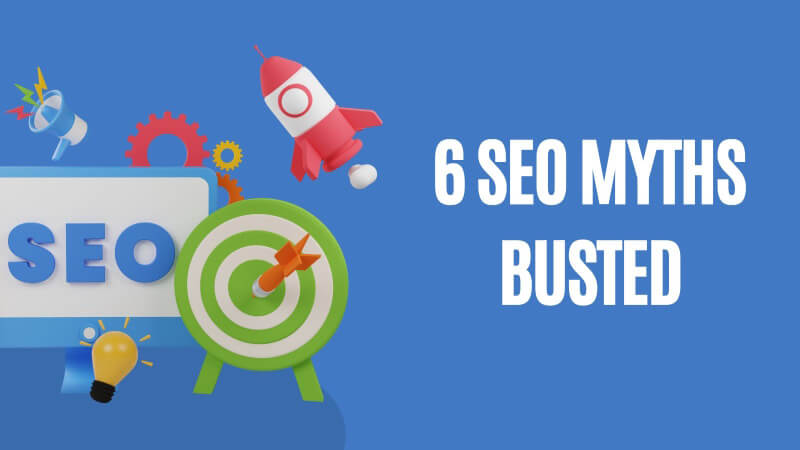6 SEO Myths BUSTED

Ranking in the top results of search engines, especially Google, is critical when trying to run a successful business. That’s why SEO (Search Engine Optimization) has developed as an art form as well as its own niche; people want to know the “secret” of how to get to #1 and will devote time and/or money to do so.
If you do a search for “SEO copywriting tips” you’ll get lots of results that essentially parrot back the same information: use an active voice, write intriguing headlines, include links, use meta tags etc. But some popular beliefs about SEO are just flat-out wrong. Here are a few we’d like to make you aware of:
Myth 1
The keyword is dead. Google killed its keyword tool and the latest algorithm tweak called Hummingbird added ability to search using natural language queries. This lead many SEO copywriting blogs to proclaim the “death” of the keyword.
Reality
The keyword isn’t dead. As Monty Python might say: it’s just resting. You still need/want to do some keyword research but now the focus is more on LSI, otherwise known as semantic searching. This involves using more synonyms and related words in your web content than simply one word or phrase repeated again and again.
Myth 2
Longer is better. When people are searching for something, they want as much detail as possible from a reliable source. Studies of Google search results have shown longer articles are better; Brian Dean found the average word count of top search results was 1447. It has also been shown that longer copy tends to convert better.
Reality
Length doesn’t matter. According to representative John Mueller, Google doesn’t count words on a page to determine ranking; in a comment thread, he cited the fact that Google also searches 140-character Twitter posts.
Sometimes a short article will still generate a lot of shares or comments, which does affect placement. The key is to make sure your SEO copywriting content is unique and compelling, and that’s the long and short of it.
Myth 3
Descriptions and ALT tags for your images are important to ranking. You may have images on your page or website, and they help with design and engagement. But according to some sources, including descriptive names or ALT tags for your images will also help with your search engine rankings.
Reality
Image tags do not greatly affect ranking. It may aid with user accessibility or getting your images to appear in Google image results. But according to the Open Algorithm Project, this oft-cited SEO copywriting tip doesn’t dramatically lead to a better listing of your web page or site.
Myth 4
Authorship is very important. Google made a big to-do of its Authorship program and suggested linking content or articles to a Google+ account would help with page ranking. There were also studies claiming to show that a link on a SERP (Search Engine Results Page) that had a Google author photo got more clicks.
Reality
Authorship is no longer an important SEO factor. For a variety of reasons known and unknown, Google devalued the Authorship program, removing the author image in SERP listings. Some have speculated that this is due to it competing with advertised content, others felt it probably got abused. Whatever happened, the authorship markup tool has disappeared. Some speculate, authorship will rise again in a different form. Until then, don’t sweat it.
Myth 5
If you have duplicate content, you will be penalized. Many a webmaster have feared a so-called “duplicate content penalty” that can affect rankings. It is thought that if you have more than one page with the same content or many urls pointing to one page you could be de-listed or even blacklisted.
Reality
Duplicate content is OK for legitimate websites. According to Google: “Duplicate content on a site is not grounds for action on that site unless it appears that the intent of the duplicate content is to be deceptive and manipulate search engine results.” This means if your website is not purposely trying to fool Google or scrape content illegally from other sites, you will not be punished.
This is different from A/B testing, using slightly different wording on multiple web pages, which Google asks you use rel = ”canonical” rather than a noindex meta tag. (For more guidance on multivariate testing, check this article.) Look to add new content of course, but don’t fret too much about the existing dupes.
Myth 6
Google’s search results are rigid so once you make it to the top, your site is fine. Additionally, people often believe there is a “secret” to getting into the top results that some self-proclaimed SEO experts have inside knowledge about.
Reality
In actuality, the “engine” of search is constantly evolving – Google changes their algorithm 500-600 times per year. And, as Google spokesman Matt Cutts explains in this colorful video, the results are always in flux.
In addition, current or former Google employees won’t spill their secrets not only because of confidentiality agreements, but also because they don’t believe in the concept of “gaming the system” to rank in results.
This means, aside from Google’s Search Engine Optimization Starter Guide, which outlines best practices and was last updated in 2010, everything else is largely speculation by outside parties.
What’s the one thing about search engine results and SEO we know will never change? Well-written, original, informative content will always be rewarded and in the long run, perform best.
Looking for good writers? Open an account at Writtent.com and get connected today!

Comments (0)